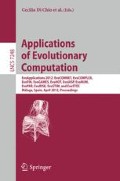Abstract
Computational neuroscience is a discipline devoted to the study of brain function from an information processing standpoint. The ventral stream, also known as the “what” pathway, is widely accepted as the model for processing the visual information related to object identification. This paper proposes to evolve a mathematical description of the ventral stream where key features are identified in order to simplify the whole information processing. The idea is to create an artificial ventral stream by evolving the structure through an evolutionary computing approach. In previous research, the “what” pathway is described as being composed of two main stages: the interest region detection and feature description. For both stages a set of operations were identified with the aim of simplifying the total computational cost by avoiding a number of costly operations that are normally executed in the template matching and bag of feature approaches. Therefore, instead of applying a set of previously learned patches, product of an off-line training process, the idea is to enforce a functional approach. Experiments were carried out with a standard database and the results show that instead of 1200 operations, the new model needs about 200 operations.
Access this chapter
Tax calculation will be finalised at checkout
Purchases are for personal use only
Preview
Unable to display preview. Download preview PDF.
References
Bartlet, W.: SEEMORE: Combining Color, Shape, and Texture Histogramming in a Neurally Inspired Approach to Visual Object Recognition. Neural Computation 9, 777–804 (1997)
Chih-Chung, C., Chih-Jen, L.: LIBSVM: a library for support vector machines. ACM Transactions on Intelligent Systems and Technology 2(27), 1–27 (2011) Software available at, http://www.csie.ntu.edu.tw/~cjlin/libsvm
Fei-Fei, L., Fergus, R., Perona, P.: Learning generative visual models from few training examples: an incremental Bayesian approach tested on 101 object categories. In: IEEE Workshop on Generative-Model Based Vision, CVPR 2004 (2004)
Fukushima, K.: Necognitron: A Self-Organizing Neural Network Model for a Mechanism of Pattern Recognition Unaffected by Shift in Position. Biological Cybernetics 36, 193–202 (1980)
Holland, J.H.: Complex Adaptive Systems. A New Era in Computation 121(1), 17–30 (1993)
Hubel, D., Wiesel, T.: Receptive Fields of Single Neurones in the Cat Striate Cortex. J. Physiol. 148, 574–591 (1959)
Hubel, D.: Exploration of the Primary Visual Cortex. Nature 299, 515–524 (1982)
LeCun, Y., Bottou, L., Bengio, Y., Haffner, P.: Gradient-based Learning applied to Document Recognition. Proceedings of the IEEE (1998)
Riesenhuber, M., Poggio, T.: Hierarchical Models of Object Recognition in Cortex. Nature Neuroscience 2(11), 1019–1025 (1999)
Mutch, J., Lowe, D.: Object Class Recognition and Localization Using Sparse Features with Limited Receptive Fields. International Journal of Computer Vision, IJCV (2008)
Serre, T., Wolf, L., Bilechi, S., Riesenhuber, M., Poggio, T.: Robust Object Recognition with Cortex-Like Mechanisms. IEEE Transactions on Pattern Analysis and Machine Intelligence 29(3), 411–426 (2007)
Ullman, S., Vidal-Naquet, M., Sali, E.: Visual features of intermediate complexity and their use in classification. Nature Neurosciencie 5(7), 682–687 (2002)
Ungerleider, L., Haxby, J.: “’What’ and ’where’ in the Human Brain”. Current Opinion in Neurobiology 4, 157–165 (1994)
Author information
Authors and Affiliations
Editor information
Editors and Affiliations
Rights and permissions
Copyright information
© 2012 Springer-Verlag Berlin Heidelberg
About this paper
Cite this paper
Clemente, E., Olague, G., Dozal, L., Mancilla, M. (2012). Object Recognition with an Optimized Ventral Stream Model Using Genetic Programming. In: Di Chio, C., et al. Applications of Evolutionary Computation. EvoApplications 2012. Lecture Notes in Computer Science, vol 7248. Springer, Berlin, Heidelberg. https://doi.org/10.1007/978-3-642-29178-4_32
Download citation
DOI: https://doi.org/10.1007/978-3-642-29178-4_32
Publisher Name: Springer, Berlin, Heidelberg
Print ISBN: 978-3-642-29177-7
Online ISBN: 978-3-642-29178-4
eBook Packages: Computer ScienceComputer Science (R0)

